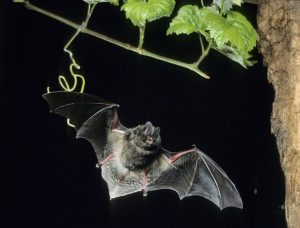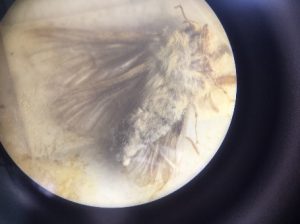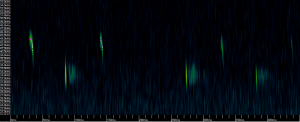By Chris Wyver – GWCT Placement student.
Considered one of the most endangered bats in western Europe, the barbastelle bat (Barbastella barbastellus) has been recorded, albeit in small numbers, in central and southern England and Wales. The barbastelle is a medium sized bat, weighing between 6-13g, and can be identified by its black fur and pug-like nose. It is estimated that there are around 5,000 individuals in the UK (Harris et al. 1995). Due to their rarity, the AgriBats team were excited to identify several of the projects recordings as barbastelles and hope this data can be used to improve farmland foraging habitats for this species.

Habitat
The barbastelle is predominantly considered a woodland species, using hollow or storm damaged trees for roosting and winter hibernation (Russo et al., 2005), as well as using old buildings and underground sites such as mines.
Foraging habitats are very variable, and include woodland, the edges of water bodies, unimproved grassland and hedgerows which may be bordered by agri-environment field margin habitats. Urban areas are generally avoided by barbastelle bats, which may be due to increased disturbance and low prey abundance associated with urban areas.
Foraging & Diet
Barbastelles can travel up to 20 km to reach their foraging grounds (Zeale et al., 2012) and moths (Lepidoptera) dominate diet, accounting for 73-94% of the volume of recovered food items found in droppings. This is unlike most other European bats, whose diet rarely consists of more than 10% moth (Rydell et al., 1996). Other important food groups include various types of fly (Diptera), which made up 4-17% of the barbastelle diet in this study.
The feeding habits of this species are unusual since midges appear to be taken infrequently (Diptera, Chironomidae), despite forming a large part of the diet of most other bats found in the UK. As well as this, the absence of non-flying prey from the droppings of the barbastelle indicate that the bat does most of its hunting in flight in a process known as ‘aerial-hawking’, where prey is pursued and caught in flight.

Echolocation
Barbastelle bats alternate between two signal types, both far exceeding the range of human hearing. Type 1 calls start at 33-49kHz, last for around 5ms, then drop to 24-37kHz. Type 2 calls start at 34-47kHz, last around 10ms and drops to 24-37kHz (Dietz & Kieffer, 2016). It is thought that the type 1 signals are important in helping the barbastelles navigate through tree-tops and woodland clearings, whereas the type 2 signals are useful for catching prey (Denziger et al., 2001).

Distribution, protection and conservation
There are only 4 known Barbastelle breeding roosts in the UK, although it is thought that this number may be an underestimation since relatively little is known about the biology of the barbastelle compared with other bat species. There are currently very few recorded maternity roost sites in the UK, with the majority of records coming from caves and abandoned mines (JNCC, 2017). Because of their rarity, the barbastelle is protected under Annex II of the EC Habitats Directive, and in the UK, seven sites where maternity roosts and hibernations sites have been found have all been designated as Special Areas for Conservation (JNCC, 2017). At a global scale, the barbastelle is considered Near Threatened (IUCN, 2017a), and within Europe, Vulnerable, on the IUCN Red List of Threatened Species (IUCN, 2017b).
It has been recommended that conservation efforts should target the environment within 7km of roost sites, focussing on hedgerows and other linear features with the aim of improving connectivity between roost and foraging sites (Zeale et al., 2012). The conservation of deciduous woodland has also been encouraged, as have areas rich in moths, such as riparian zones and organically managed farmland (Ancillotto et al., 2015).
References
Ancillotto, L., Cistrone, L., Mosconi, F., Jones, G., Boitani, L., & Russo, D. (2015). The importance of non-forest landscapes for the conservation of forest bats: Lessons from barbastelles (Barbastella barbastellus). Biodiversity and Conservation, 24(1), 171-185.
Denzinger, A., Siemers, B., Schaub, A., & Schnitzler, H. (2001). Echolocation by the barbastelle bat, Barbastella barbastellus. Journal of Comparative Physiology A: Sensory, Neural, and Behavioral Physiology, 187(7), 521-528.
Dietz, C., & Kiefer, A. (2016). Bats of Britain and Europe. London: Bloomsbury
Harris S., Morris, P., Wray, S. & Yalden, D. (1995) A review of British mammals: population estimates and conservation status of British mammals other than cetaceans. JNCC: Peterborough.
IUCN. (2017a). Barbastella barbastellus. Available: http://www.iucnredlist.org/details/2553/0.
IUCN. (2017b). Barbastella barbastellus. Available: http://www.iucnredlist.org/details/2553/1.
JNCC. (2017). 1308 Barbastelle Barbastella barbastellus – SAC selections species account. Available: http://jncc.defra.gov.uk/ProtectedSites/SACselection/species.asp?FeatureIntCode=S1308.
Russo, D., Cistrone, L., Jones, G., & Kelt, D. (2005). Spatial and temporal patterns of roost use by tree-dwelling barbastelle bats Barbastella barbastellus. Ecography, 28(6), 769-776.
Rydell, J., Natuschke, G., Theiler, A., & Zingg, P. E. (1996). Food habits of the barbastelle bat Barbastella barbastellus. Ecography, 19(1), 62-66.
Zeale, M. R. K. Davidson-Watts, I., & Jones, G. (2012). Home range use and habitat selection by barbastelle bats (Barbastella barbastellus): Implications for conservation. Journal of Mammalogy, 93(4), 1110-1118.

I appreciate you sharing this blog article. Keep writing. Valentina Sax Marla